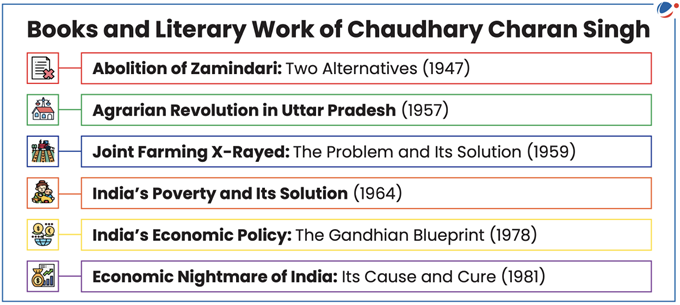Why in the news?
P.V. Narasimha Rao, Chaudhary Charan Singh, MS Swaminathan, L K Advani, Karpoori Thakur received India’s highest civilian award Bharat Ratna.
About Bharat Ratna
- It is India’s highest civilian award, granted by President to individuals for outstanding service across any field, irrespective of race, occupation, position, or gender.
- Recommendations: Made by the Prime Minister of India to the President (No formal recommendations for this are necessary)
- Recognition: Recipients receive a Sanad (certificate) signed by the President along with a medallion. Notably, the award does not come with any monetary grant.
- Establishment: It was instituted by former President Dr. Rajendra Prasad on January 2, 1954.
- Regulations: Article 18(1) of the Indian Constitution prohibits awardees from using 'Bharat Ratna' as a title, prefix or suffix to their name.
- However, they are allowed to include 'Awarded Bharat Ratna by the President' or 'Recipient of Bharat Ratna Award' in their biodata, visiting cards, letterheads, etc.
- Initial Awardees: Dr. Sarvapalli Radhakrishnan, Dr. CV Raman, and Chakravarti Rajagopalachari were the first recipients of the Bharat Ratna in 1964.
- Notably, the award is also open to non-Indians, as demonstrated by the likes of Mother Teresa, Khan Abdul Ghaffar Khan, and Nelson Mandela.
- Additional Information:
- Initially, the award was not conferred posthumously, but this changed in 1966 when awarded to Lal Bahadur Shastri.
- The youngest recipient and first sportsperson to be honored with the award was Sachin Tendulkar in 2014.
- A maximum of three awards can be given each year, with an exception occurring this year 2024 and in 1999 when five and four individuals received the honor respectively.
Design of Bharat Ratna Medal
|
About PV Narasimha Rao:
- Personal Life: PV Narasimha Rao was born on June 28, 1921, in Telangana, India. He pursued higher education in law and literature. Rao proficient in multiple languages including Telugu, English, Urdu, Sanskrit, and Hindi.
- Political Career: PV Narasimha Rao had a distinguished political career spanning several decades.
- He served as the Chief Minister of Andhra Pradesh from 1971 to 1973, showcasing early leadership skills.
- On the national stage, he held key ministerial portfolios including External Affairs, Home Affairs, Defense, and Human Resource Development.
- His tenure as Prime Minister from 1991 to 1996 was marked by significant economic reforms and diplomatic initiatives.
- Reforms Taken Up by Him:
- Economic Reforms: He spearheaded economic liberalization in India, dismantling the restrictive policies of the license raj. He introduced measures to make Indian industries more competitive, attract foreign investment, and foster market-oriented growth.
- Constitutional Reforms: His tenure witnessed significant constitutional amendments, including the 73rd and 74th Constitutional Amendments Act, which decentralized governance and empowered local bodies.
- Diplomatic Initiatives: He played a pivotal role in India's foreign policy, hosting the Seventh Summit of the Non-Aligned Movement in 1983 and leading a Special Non-Aligned Mission to West Asia to resolve the Palestinian Liberation Organization issue. He also established diplomatic ties with Israel and initiated the Look East Policy to strengthen engagement with Southeast Asian countries.
- Improvement of Indo-US Relations: He worked towards improving relations with the United States, fostering cooperation in trade, defense, and technology transfer.
About Chaudhary Charan Singh:
- Personal Life:
- Born on December 23, 1902, in Nurpur, Meerut district, Uttar Pradesh.
- Raised in a peasant farming family
- Influenced by the Arya Samaj's ideal of a casteless Hindu society and Gandhi's teachings on rural development.
- Political Career:
- He served two terms as the Chief Minister of Uttar Pradesh from 1967 to 1968, followed by a second term in 1970.
- He held cabinet-level positions in Uttar Pradesh from 1951 to 1967. During this time, he focused on legislation concerning revenue, land, agriculture, forests, and law & order.
- He briefly served as the Prime Minister of India from July 1979 to 1980. His tenure was short-lived, lasting for about a year.
- Reforms taken up by him:
- Introduced the Debt Redemption Bill (1939): He was the chief architect of land reforms in U.P and took a leading part in formulation and finalisation of the Dept. Redemption Bill 1939, which brought great relief to rural debtors.
- Drafted the Land Utilization Bill (April 1939) to transfer proprietary interest in agricultural holdings to tenants.
- Role in Eradication of the Zamindari System in Uttar Pradesh: It was due to his efforts that the legislations such as the Uttar Pradesh Zamindari and Land Reform Act, 1952, resulted in the abolition of Zamindari throughout the State.
- Uttar Pradesh Consolidation of Holding Act, 1953: Paved the way for consolidation of land holdings of rich and medium peasants.
- Uttar Pradesh Soil Conservation Act, 1954: aimed at containment of gradual soil erosion and decline in productivity of soil, were placed on the statute book.
- Land Holding Act 1960: He was instrumental in bringing about this law which aimed at lowering the ceiling on land holdings to make it uniform throughout the State.

Related News: Padma Awards
|





